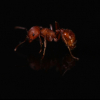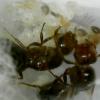- Formiculture.com
- Forums
- Gallery
- Members
- Member Map
- Chat

11 replies to this topic
#1
 Offline
-
Posted September 2 2015 - 7:24 PM
Offline
-
Posted September 2 2015 - 7:24 PM
Hi all,
I'm looking for documentation that shows the nest's optimal humidy-level according to the ant's family or species. Does anyone have any suggestions? I'm asking because I'm trying to produce a formicarium that has an adjustable humidy control, and with that, I`d like to know what to set it to when I put a given colony inside. Thanks in advance for reading this.
~Dan
I'm looking for documentation that shows the nest's optimal humidy-level according to the ant's family or species. Does anyone have any suggestions? I'm asking because I'm trying to produce a formicarium that has an adjustable humidy control, and with that, I`d like to know what to set it to when I put a given colony inside. Thanks in advance for reading this.
~Dan
~Dan
#2
 Offline
-
Posted September 3 2015 - 4:23 AM
Offline
-
Posted September 3 2015 - 4:23 AM
It isn't comprehensive, but http://www.antstore.net/shop/ants/has that kind of information about the species they sell. I imagine a lot of North American species are absent, given that shipping from most of North America is illegal, but you might be able to find ants of the same genus or ants from similar habitats to base an estimate on.
- Works4TheGood likes this
#3
 Offline
-
Posted September 3 2015 - 6:05 AM
Offline
-
Posted September 3 2015 - 6:05 AM
Quite a few people have commented on the fact that members from North America focus a lot more on hydration than other locations.
There were several posts where people using some types of European or Chinese ant nests failed to get their North American ants to thrive, despite several people having great success with the same nest using a non-North American species.
It may be that North American species may be a bit more dependant on higher humidity (with some exceptions, like desert species).
- LC3 and spinyeti like this
"Always do right. This will gratify some people, and astound the rest." -- Samuel Clemens
#4
 Offline
-
Posted September 3 2015 - 8:11 AM
Offline
-
Posted September 3 2015 - 8:11 AM
I've been curious as well. Here's a few papers I dug up, please share if you find copies of the ones behind paywalls!
http://link.springer...1007/PL00001728
http://www.pnas.org/...3/4765.full.pdf
https://books.google...umidity&f=false
http://www.chowyang....4359966/063.pdf
http://link.springer...0040-003-0685-1
- Works4TheGood likes this
Camponotus vicinus, Crematogaster 1, Crematogaster 2, Formica francoeuri, *, *, Myrmecocystus testaceus, Novomessor cockerelli, Pheidole hyatti, Pogonomyrmex californicus, Pogonomyrmex rugosus, Solenopsis invicta
#5
 Offline
-
Posted September 3 2015 - 11:52 AM
Offline
-
Posted September 3 2015 - 11:52 AM
Quite a few people have commented on the fact that members from North America focus a lot more on hydration than other locations.
There were several posts where people using some types of European or Chinese ant nests failed to get their North American ants to thrive, despite several people having great success with the same nest using a non-North American species.
It may be that North American species may be a bit more dependant on higher humidity (with some exceptions, like desert species).
I just started ant keeping this summer. I'm currently keeping roughly 30 queens in an incubation aquarium in my basement. Coincidentally, the aquarium sits immediately next to my dehumidifier that's set at 55% humidity. Interestingly, all of my queens, without exception, huddle towards the wet cotton in their test tube setups. I should probably adjust my dehumidifier to allow for more.
~Dan
#6
 Offline
-
Posted September 3 2015 - 12:05 PM
Offline
-
Posted September 3 2015 - 12:05 PM
Judging from the resources that you're showing me, I won't be spoon-fed the humidity levels that I'm really searching for. ![]()
I'll probably make this into a two-stage process. First, I'll use my hygrometer probe to record the humidity level at each setting that my formicarium offers. Then, I'll introduce the colonies and watch them. If they huddle towards the wet cotton, then I'll move the formicarium's switch to provide more moisture. If they avoid the wet cotton, then I'll do the opposite. Once I finally see them mostly in between, I'll document what the humidity level should be at that configuration of the formicarium for that species. Does that sound reasonable?
Question: Will the queens place their brood on wet cotton?
~Dan
#7
 Offline
-
Posted September 3 2015 - 1:41 PM
Offline
-
Posted September 3 2015 - 1:41 PM
Some species like to place brood on damp objects. Some don't.
Most species, once settled, will huddle near the wet cotton because it is the furthest from the entrance. They can't dig away from the surface, so they will put as much distance between them and the outside world (with all of its predators) as they can.
Many like to keep their eggs and larvae in really damp location, but prefer to keep brood in drier/warmer locations.
"Always do right. This will gratify some people, and astound the rest." -- Samuel Clemens
#8
 Offline
-
Posted September 4 2015 - 5:37 AM
Offline
-
Posted September 4 2015 - 5:37 AM
I notice that regardless of the humidity, lots of queens, such as Lasius sp. Will huddle around the wet cotton almost religiously.
#9
 Offline
-
Posted September 4 2015 - 5:38 AM
Offline
-
Posted September 4 2015 - 5:38 AM
I've seen a lot of them keep eggs in the dry area along with pupae, while only putting larvae where it's moist.
#10
 Offline
-
Posted September 4 2015 - 7:50 AM
Offline
-
Posted September 4 2015 - 7:50 AM
With my messor barbarus, I know how to adjust humidity for the ants based on where they are (currently) keeping the brood in the nest.
There are four chambers in the nest: A, B, C, and D. Chambers D and C and furthest from chamber A, and chamber B is closes to chamber A.
I always water the same area of the nest--chamber A. This means that chamber D is always the driest, and chamber A is always the most humid.
Now, if the ants are in chamber D, the furthest away from chamber A, they're humid enough and I don't need to add any water.
If they're in chamber A, which will hold humidity the longest because it's always the last-watered spot, they need more water.
After watering chamber A, they'll move back to chamber D, which is now the driest area. As the humidity decreases over the next week, they'll move from D back to C or B, then finally to A.
When they get back to A, I water again. Then they move furthest away from chamber A, to chamber D, and the cycle repeats.
In short, create a humidity gradient, and where the ants keep the brood in that gradient tells you how much humidity they prefer.
#11
 Offline
-
Posted September 5 2015 - 5:50 AM
Offline
-
Posted September 5 2015 - 5:50 AM
In a nest having a gradient always seems the best for the ants both temperature and humidity.
#12
 Offline
-
Posted September 5 2015 - 7:22 AM
Offline
-
Posted September 5 2015 - 7:22 AM
Ants have weird habits. Even in the same species there are variations. Just create a gradient and have water for workers to drink. Having a liquid feeder also allows workers to go out, drink some water, and spit it inside the nest for more hydration. German Camponotus keepers seem to do that some time wit huge colonies.
Species I keep:
1 Lasius cf. Neoniger 30 workers
1 Camponotus sp. 15 workers
20 Tetramorium SpE 30 workers
1 T. Sessile 200 workers
1 user(s) are reading this topic
0 members, 1 guests, 0 anonymous users


















